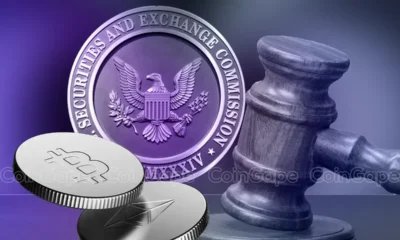Market
Fintech Leaders Push for US Federal Regulatory Sandbox

Regulatory sandboxes have emerged as a concept to drive innovation in a controlled setting. They allow companies to test new crypto products and services while regulators observe and adapt regulations. While jurisdictions like the UK, the UAE, and Singapore have already created sandboxes, the US has yet to create one at the federal level.
BeInCrypto spoke with representatives of OilXCoin and Asset Token Ventures LLC to understand what the US needs to build a federal regulatory sandbox and how it can unify a fragmented testing environment for innovators.
A Patchwork Approach
As the name suggests, regulatory sandboxes have emerged as a tool for providing a controlled testing ground. This environment allows entrepreneurs, businesses, industry leaders, and lawmakers to interact with new and innovative products.
According to the Institute for Reforming Government, 14 states in the United States currently have regulatory sandboxes for fintech innovation.
Of those, 11 are industry-specific and cover other sectors like artificial intelligence, real estate, insurance, child care, healthcare, and education.

Utah, Arizona, and Kentucky are the only jurisdictions among these states with an all-inclusive sandbox. Meanwhile, all but 12 states are currently considering legislation to create some regulatory sandbox for innovation.
Due to its relatively short existence, the crypto market has underdeveloped legislation. While state-level sandboxes enable innovators to demonstrate their products’ capabilities to the public, they are significantly constrained by the lack of federal regulatory sandboxes.
The Need for Federal Oversight
Though statewide efforts to create regulatory sandboxes are vital for innovation, entrepreneurs and businesses still face constraints in developing across borders or reaching an audience at a national level.
“The existing state-level regulatory sandboxes in the US have provided some room for innovation, but they remain limited in scope and impact. Operating at the state-level means they lack the scale and consistency needed to provide meaningful regulatory clarity for businesses operating across multiple jurisdictions,” Dave Rademacher, Co-founder of OilXCoin, told BeInCrypto.
Rapid advancements in fields like blockchain and artificial intelligence (AI) add a particular layer of uncertainty, given that existing legal frameworks may not be well-suited to these technologies.
“Since crypto and blockchain technologies inherently function on a global scale, a fragmented regulatory environment makes compliance difficult and creates uncertainty for both startups and institutional investors,” Rademacher added.
At the same time, regulators may face difficulties in developing appropriate rules for these technologies due to a potential lack of familiarity with these constantly changing industries.
As a result, industry participants are increasingly calling for creating a federal regulatory sandbox. This environment could be a collaborative framework to address the gap, facilitating communication and knowledge sharing between regulators and industry stakeholders.
“The implementation of a federal regulatory sandbox in the United States has the potential to significantly enhance both innovation and regulatory oversight by reducing the uncertainties often associated with navigating the regulatory landscape across state lines. Such an initiative could help establish a coherent framework characterized by uniformity, continuity, and a conducive environment for innovation,” said Paul Talbert, Managing Director of ATV Fund.
According to Rademacher and Talbert, this proposal would meet the needs of all players involved.
Benefits of a Federal Regulatory Sandbox
A sandbox provides innovators with a controlled environment to test products under regulatory oversight without the immediate burden of full compliance with rules that may not yet fit their technology.
It also allows regulators to acquire firsthand insights into blockchain applications, facilitating the creation of more knowledgeable and flexible regulatory policies.
“Startups should have clear eligibility criteria to determine their qualification for participation, while regulators must outline specific objectives—whether focused on refining token classification frameworks, testing DeFi applications, or improving compliance processes,” Rademacher said.
It could also help the United States reinforce its position as a leader in technological innovation.
“By fostering innovation through simplicity, regulatory certainty, and conducive environments, the United States can significantly strengthen its competitive position in the global fintech landscape,” Talbert added.
While the United States has stalled in creating a federal framework for fintech innovation, other jurisdictions around the world have already gained significant ground in this regard.
Global Precedents
The Financial Conduct Authority (FCA), which regulates the United Kingdom’s financial services, launched the first regulatory sandbox in 2014 as part of Project Innovate. This initiative aimed to provide a controlled environment for testing innovative products.
The government asked the FCA to establish a regulatory process to promote new technology-based financial services and fintech and ensure consumer protection.
Following the UK’s lead, Abu Dhabi, Denmark, Canada, Hong Kong, and Singapore also established regulatory sandboxes.
The United Arab Emirates (UAE) and Singapore, in particular, have made progressive strides in creating federal regulatory sandboxes.
The UAE, for example, currently has four different sandboxes: the Abu Dhabi Global Market (ADGM) Regulation Lab, the DSFA Sandbox, the CBUAE FinTech Sandbox, and the DFF Regulation Lab.
Their focus areas include digital banking, blockchain, payment systems, AI, and autonomous transport.
Meanwhile, the Monetary Authority of Singapore (MAS) launched its Fintech Regulatory Sandbox in 2016. Three years later, MAS also launched the Sandbox Express, providing firms with a faster option for market testing certain low-risk activities in pre-defined environments.
“The success of regulatory sandboxes in jurisdictions such as the United Kingdom, Singapore, and the United Arab Emirates has highlighted the importance of key attributes: regulatory collaboration, transparent processes, continuous monitoring, and the allocation of dedicated resources. As a result, a growing number of jurisdictions worldwide are looking to replicate the frameworks established by these pioneering countries to strengthen their competitive position in the global fintech landscape,” Talbert said.
Rademacher believes these jurisdictions’ innovations should prompt the United States to accelerate its progress.
“Rather than focusing on maintaining a competitive edge, the priority should be on reclaiming lost ground. The US has lagged behind jurisdictions like the UAE and Singapore, which have implemented clear regulatory pathways that attract capital and talent. A federal sandbox would be a critical step in restoring the country’s leadership in financial innovation,” he said.
For that to happen, the United States must overcome certain hurdles.
Challenges of a Fragmented US Regulatory Landscape
A fragmented network of federal and state agencies overseeing financial services presents a key challenge to establishing a US federal regulatory sandbox.
“Unlike other countries with a single financial authority overseeing the market, the U.S. has multiple agencies—including the SEC, CFTC, and banking regulators—each with different perspectives on how digital assets should be classified and regulated. The lack of inter-agency coordination makes implementing a unified sandbox more complex than in jurisdictions with a single regulatory body,” Rademacher told BeInCrypto.
Yet, in recent years, important SEC and CFTC actors have expressed interest in adopting a more favorable regulatory approach to innovation.
In September 2023, when Caroline Pham was still a CFTC Commissioner, she proposed launching federal regulatory sandboxes or pilot programs to stay ahead of the innovation curve. SEC Commissioner Hester Peirce has made similar statements in the past.
“Even though I tend to be more of a beach than a sandbox type of regulator, sandboxes have proven effective in facilitating innovation in highly regulated sectors. Experience in the UK and elsewhere has shown that sandboxes can help innovators try out their innovations under real-world conditions. A sandbox can provide a viable path for smaller, disruptive firms to enter highly regulated markets to compete with larger incumbent firms,” Peirce said in a statement last May.
However, the full scope of national regulations far exceeds the authority of these two entities.
Congressional and Constitutional Hurdles
Any legislative measure to develop a federal regulatory framework for sandboxes in the United States would have to undergo Congressional approval. Talbert highlighted several potential constitutional dilemmas the promotion of an initiative of this nature may face.
“These dilemmas include issues related to the non-delegation doctrine, which raises concerns about the constitutionality of delegating legislative power; equal protection considerations under the Fifth Amendment’s Due Process Clause; challenges arising from the Supremacy Clause; and implications under the Administrative Procedure Act (APA) and principles of judicial review,” he said.
To address these complexities, Congress must enact clear legal boundaries that ensure a regulatory framework is both predictable and open. Given the current administration’s emphasis on technological innovation, the prospects for creating a sandbox appear positive.
“Given the current composition of Congress, which aligns with the political orientation of the new executive branch, there may be a timely opportunity for regulatory reform. Such reform could facilitate the creation of a cohesive federal regulatory framework and enhance collaboration among federal agencies,” Talbert told BeInCrypto.
However, creating a federal regulatory sandbox is not a one-size-fits-all solution.
Balancing State Autonomy and Federal Regulations
State autonomy is enshrined in the US Constitution. This protection means that, even though a regulatory sandbox may exist at the national level, individual states still have the authority to restrict or prohibit sandboxes within their jurisdictions.
Encouragingly, most US states are already exploring regulatory sandboxes, and the states that have already implemented them represent diverse political viewpoints.
“Despite these hurdles, it is noteworthy that the establishment of state regulatory sandboxes has historically transcended partisan politics, with representatives from both major political parties recognizing the economic advantages of instituting regulatory frameworks that augment their states’ competitive positions,” Talbert said.
However, other considerations beyond political resistance must also be addressed.
“A federal regulatory sandbox might also face opposition from established financial institutions, including banks, which may perceive potential threats to their existing business models. Furthermore, federal budgetary constraints could impede the government’s capacity to support the development and maintenance of a federal regulatory framework,” Talbert added.
Effective federal regulations will also require a balance between businesses’ concerns and regulators’ responsibilities.
“The two biggest risks are overregulation—imposing excessive restrictions that undermine the sandbox’s purpose—or underregulation, failing to provide meaningful clarity. If the rules are too restrictive, businesses may avoid participation, limiting the sandbox’s effectiveness. If they are too lax, there is a risk of abuse or regulatory arbitrage. A well-executed federal regulatory sandbox should not become a bureaucratic burden but rather a dynamic framework that fosters responsible growth in the digital asset space,” Rademacher told BeInCrypto.
Ultimately, the best approach will require coordination from different governing bodies, industry stakeholders, and bipartisan collaboration.
Fostering Collaboration for a Successful Sandbox
Due to recent strained communication between tech and federal agencies, Rademacher believes fostering a cooperative atmosphere is essential for creating a functional federal sandbox.
“The approach must be collaborative rather than adversarial. Agencies should view the sandbox as an opportunity to refine regulations in real time, working alongside industry participants to develop policies that foster responsible innovation. Involvement from banking regulators and the Treasury Department could also be valuable in ensuring that digital assets are integrated into the broader financial system in a responsible manner,” he said.
Achieving this requires a bipartisan approach to harmonizing regulatory goals and setting clear boundaries. Industry collaboration with lawmakers and regulators is vital to showing how a sandbox can promote responsible innovation while safeguarding consumers.
“Its success will ultimately depend on whether it serves as a bridge between innovation and regulation, rather than an additional layer of complexity,” Rademacher concluded.
Disclaimer
Following the Trust Project guidelines, this feature article presents opinions and perspectives from industry experts or individuals. BeInCrypto is dedicated to transparent reporting, but the views expressed in this article do not necessarily reflect those of BeInCrypto or its staff. Readers should verify information independently and consult with a professional before making decisions based on this content. Please note that our Terms and Conditions, Privacy Policy, and Disclaimers have been updated.












